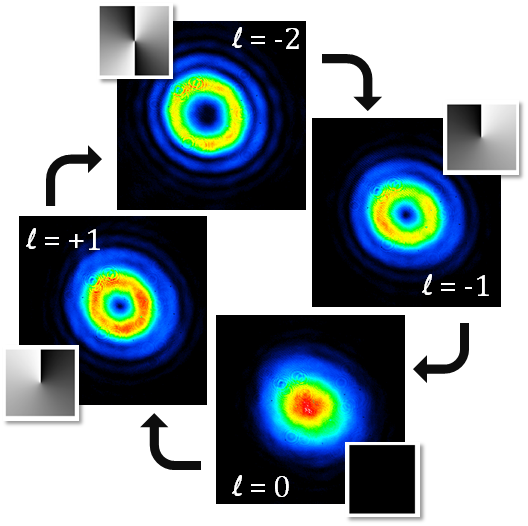Quantum information encoded in multi-level systems offer several advantages. As it allows encoding information beyond one bit per photon, both the data rate can be enhanced and the security of the communication channel can be improved in quantum communication schemes. Photons are the ideal carrier for quantum information, which can be encoded in several of its physical properties. One such property is the orbital-angular-momentum (OAM) of light, which allows photons to rotate massive particles when they are absorbed.
The OAM of photons has an – in principle arbitrary – large number of distinguishable levels, which can be used to store and transmit information. This has been exploited both in classical communication schemes (data rates of more than 100TB/sec were transmitted), and in quantum communication schemes, where photons entangled in OAM were transmitted over more than 3 kilometers in Vienna. Thus the OAM of light seems to be a good candidate for quantum communication networks in the future.
However, experimentally it has thus far been a significant challenge to transform this quantum states encoded in the OAM of light. Today’s QKD systems mostly employ the polarization of light – an intrinsically two-dimensional system – because all two-dimensional transformations can be done easily with so-called quarter and half wave plates. The latest research on quantum gates in higher-dimensions is an analogue of these two elements for the OAM of light and in higher dimensions.
The idea how to construct such basic elements was originally found by a computer algorithm called Melvin, which has been developed by the Viennese group two years ago. Based on this idea, the scientists were able to show the experimental implementation of all basic elements, necessary for a general four-dimensional transformation in their lab.
In future, it will be interesting to combine all these basic transformations and utilize these new techniques in practical as well as fundamental quantum experiments. For example, transformations in QKD schemes into a different measurement basis, so-called mutually-unbiased-bases, are necessary to ensure the unbreakable quantum security of the connection. Such transformations become now possible with the developed technique. It also opens up the possibility to investigate fundamental properties of entanglement in higher-dimensional quantum systems.

